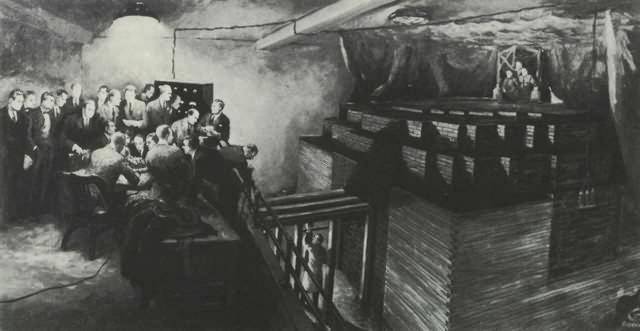The Manhattan Project stands as a monumental undertaking in human history, a top-secret endeavor during World War II that ultimately led to the creation of the first atomic bombs. But with its vast scope spanning across numerous locations and involving hundreds of thousands of people, the name “Manhattan Project” might seem geographically misleading. So, Why Was It Called The Manhattan Project? The answer lies in the project’s initial administrative setup and the conventions of the U.S. Army Corps of Engineers.
The story begins not in Manhattan, but with the burgeoning scientific understanding of nuclear fission in the late 1930s. Following the groundbreaking discovery of nuclear fission by German scientists in 1938, concerns arose that Nazi Germany might harness this power to create devastating weapons. This fear was amplified by a letter penned by Albert Einstein and Leo Szilard to President Franklin D. Roosevelt in 1939, warning of the potential for atomic bombs and urging the United States to investigate this possibility. In response, President Roosevelt established the Uranium Committee to assess the feasibility of nuclear chain reactions for military applications.
However, early research efforts progressed at a slow pace. It wasn’t until the spring of 1941, spurred by a report from the British MAUD Committee confirming the viability of an atomic bomb and advocating for collaboration with the U.S., that momentum truly picked up. The U.S. government then reorganized its atomic research under the S-1 Committee, overseen by the newly formed Office of Scientific Research and Development led by Vannevar Bush. As research transitioned towards development and the immense scale of the undertaking became apparent, Bush recognized that the S-1 Committee lacked the necessary resources for full-scale construction. The project needed the backing and logistical capabilities of the U.S. Army.
Prior to the official establishment of the Manhattan Project, significant atomic research was already underway at universities across the nation. At the University of California at Berkeley’s Radiation Laboratory, Ernest Lawrence pioneered the use of the cyclotron, a device capable of accelerating atoms to incredible speeds. Lawrence believed his “atom smasher” could be instrumental in separating Uranium-235 through electromagnetic separation, a crucial step in creating a uranium-based bomb. Simultaneously, at Berkeley, Emilio Segrè and Glenn Seaborg made another vital discovery: plutonium. They proved that this element could also sustain nuclear reactions, offering a second pathway to developing an atomic weapon.
Meanwhile, at Columbia University, a team including Enrico Fermi and Leo Szilard experimented with nuclear “piles” to study neutron emissions from fission. This research moved to the Metallurgical Laboratory at the University of Chicago in early 1942. A pivotal moment arrived on December 2, 1942, when Chicago Pile-1 achieved criticality, marking the world’s first controlled, self-sustaining nuclear chain reaction. This experiment not only validated the potential of nuclear energy but also provided a viable method for plutonium production.
The official birth of the Manhattan Project occurred on August 13, 1942. Despite the project’s eventual decentralization across the country, its initial headquarters were indeed located in Manhattan, New York City, at 270 Broadway. General Leslie R. Groves was appointed to lead this colossal undertaking. Following the U.S. Army Corps of Engineers’ convention of naming districts after their headquarters city, Groves designated the atomic bomb project as the Manhattan Engineer District (MED). Thus, “Manhattan Project” emerged as the shortened, more readily used name for this highly secretive operation.
Funding for the project rapidly materialized, with President Roosevelt approving an initial allocation of $500 million in December 1942. While the headquarters soon relocated to Washington, D.C., the name “Manhattan Project” remained, even as project sites proliferated across the United States and even into Canada. Key sites included Los Alamos, New Mexico, the central research and weapon design laboratory under J. Robert Oppenheimer; Oak Ridge, Tennessee, home to uranium enrichment facilities and pilot plutonium production; and Hanford, Washington, the site of full-scale plutonium production reactors. Numerous other locations contributed to the project, from universities conducting research to industrial companies refining materials. It’s estimated that over 600,000 people were involved in this vast network, all working towards the common goal of developing the atomic bomb before the Axis powers.
The culmination of the Manhattan Project arrived in July 1945. As the project neared completion, the U.S. government established the Interim Committee to advise on the wartime and postwar implications of atomic weapons. The committee’s Scientific Panel recommended using the bomb against Japan. On July 16, 1945, the atomic age dawned with the Trinity test at Alamogordo, New Mexico. The successful detonation of the first atomic bomb demonstrated the awesome power unleashed by nuclear fission.
In August 1945, the United States deployed atomic weapons against Japan, dropping “Little Boy” on Hiroshima and “Fat Man” on Nagasaki. These devastating events led to Japan’s surrender and the end of World War II. However, the legacy of the Manhattan Project extends far beyond the war. It ushered in the nuclear age, marked by both the perils of nuclear weapons and the potential of nuclear technology. The project sparked a nuclear arms race during the Cold War and influenced nuclear programs worldwide. Yet, it also paved the way for peaceful applications of nuclear energy, such as nuclear power generation. The environmental consequences of the project, particularly at sites like Hanford and Oak Ridge, continue to be addressed today.
In conclusion, the Manhattan Project was named not because the majority of the work was conducted in Manhattan, but because its administrative origins were there. The name, derived from the Manhattan Engineer District, reflects the Army Corps of Engineers’ naming conventions and the project’s initial, albeit brief, headquarters location. Despite its somewhat misleading geographical implication, the name “Manhattan Project” has become synonymous with the secret wartime effort that irrevocably changed the course of history and continues to shape our world today.
